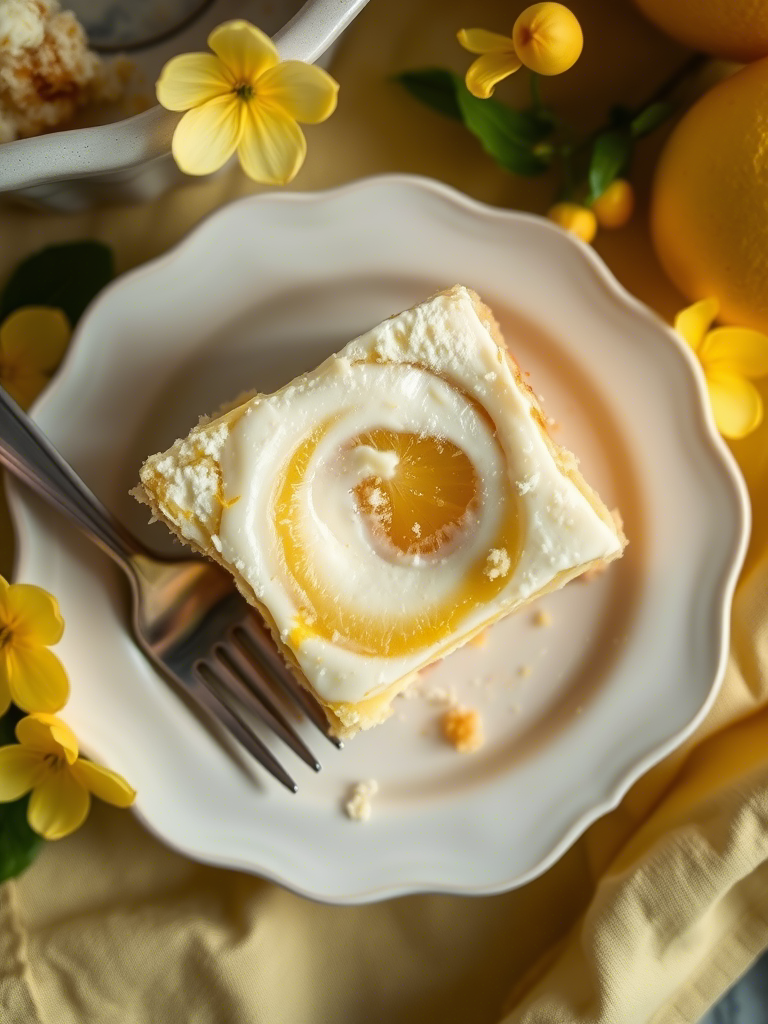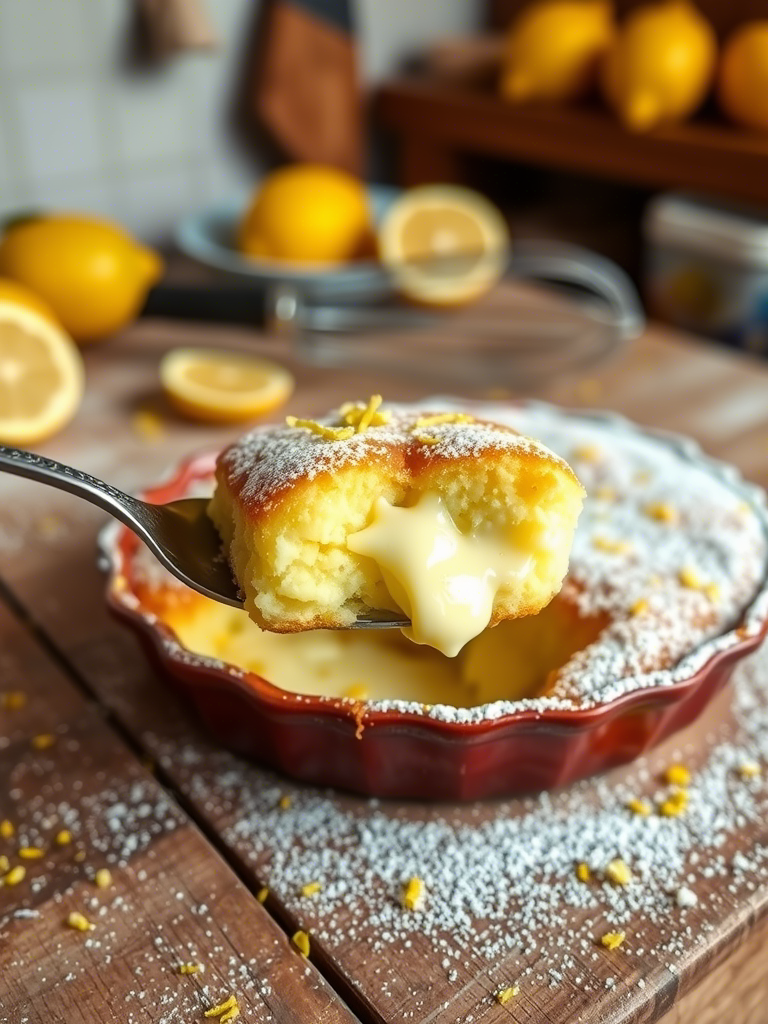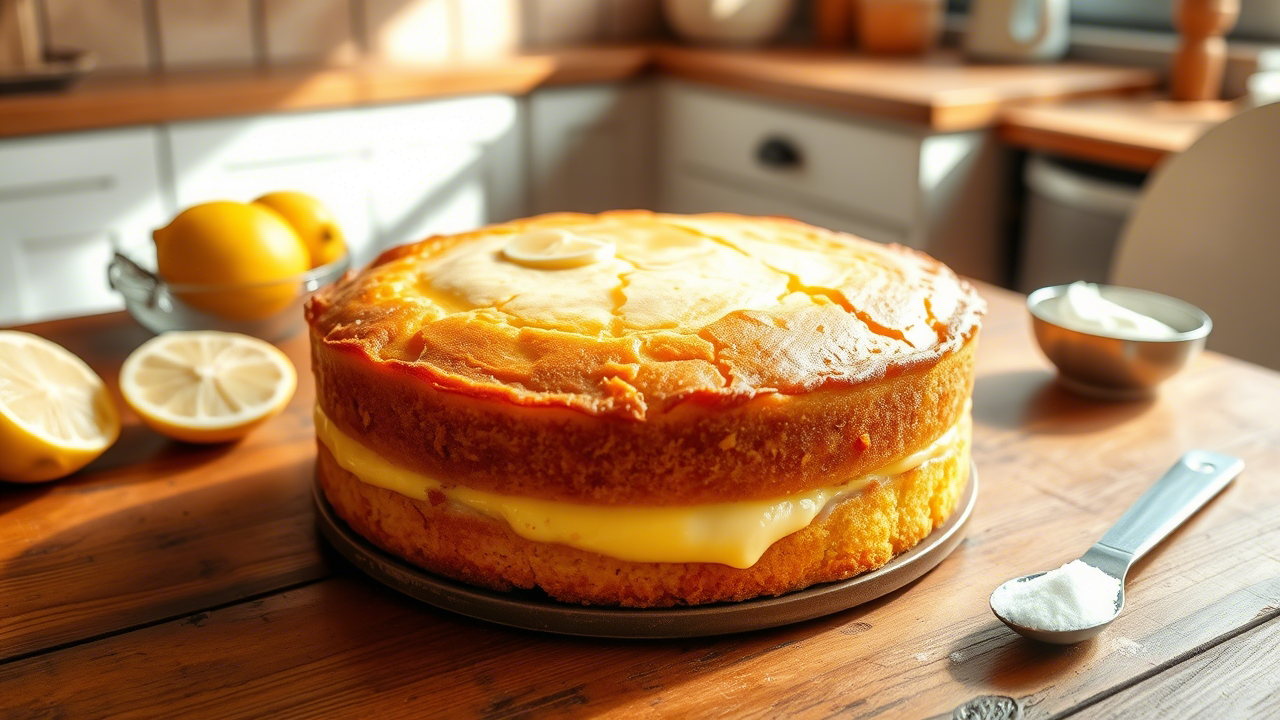It’s not every day you find a dessert that’s equal parts foolproof, indulgent, and just weirdly satisfying. But the 4-ingredient lemon cream cheese dump cake? It hits that elusive sweet spot. Professionals might scoff at the word dump, but don’t let the name fool you. This unassuming little dessert is a case study in culinary minimalism that borders on genius—equal parts chemistry and comfort food alchemy.
We’re talking just four ingredients. Four. Yet what emerges from the oven is a symphony of textures and contrasts: tangy, creamy, crumbly, warm, and golden. This isn’t just a lazy baker’s trick—there’s real technique buried in its simplicity. So today, we’re dissecting it. We’re going to pick apart what makes this thing tick, why it works, and how to optimize it like a pro, even if it sounds like something your aunt whipped up in a rush for a church picnic in 1994.
The Anatomy of a Dump Cake
First off—what even is a dump cake? Technically speaking, it’s a type of cobbler, except you don’t make a batter or dough from scratch. Instead, dry cake mix gets “dumped” on top of a base (usually fruit or pie filling), and a fat source (often butter) binds it all together as it bakes.
In this lemon cream cheese version, things get a little more interesting. Here’s the typical ingredient breakdown:
- 1 box of lemon cake mix
- 1 can of lemon pie filling
- 1 block (8 oz) of cream cheese
- 1 stick (½ cup) of unsalted butter
That’s it. But these four humble elements pull far more than their weight.
Now, let’s unpack the technique and why it actually works on a scientific level.
H2: The Chemistry Behind Cake Mix
Cake mix is engineered to be fail-proof. Commercial mixes contain flour, sugar, leavening agents, emulsifiers, and stabilizers all in precisely measured ratios. But in this dish, we don’t mix it with eggs or milk like usual. That dry layer on top gets its moisture indirectly—from the butter and steam rising up from the pie filling.
Here’s what’s wild: the Maillard reaction kicks in more deeply in spots where the butter soaks through and toasts the dry mix. That’s how you get those crispy golden peaks. It’s not just half-baked cake—it’s controlled chaos. Purposeful disarray. Like jazz with a sugar crust.
Now, if you’re using a lemon cake mix with pudding in it (some do, some don’t), the end result gets even gooier. That pre-packaged pudding element contains modified starches that thicken as they bake. The texture? Almost custard-adjacent.

H2: Lemon Pie Filling—More Than Just a Filling
Here’s the trick most people miss: lemon pie filling isn’t just flavor, it’s structural. Most commercially canned fillings are built on a base of cornstarch or modified food starch, glucose syrup, and citric acid. That acidic tang? It’s doing more than making your mouth pucker.
The acidity plays beautifully with the cream cheese. It cuts through the fat. It also boosts the perception of sweetness without overloading on actual sugar. That’s a professional tip: acidity balances desserts, prevents cloying, and elevates the whole profile.
In terms of baking behavior, that thick pie filling sits at the bottom and creates a gentle steam environment. This steam rises, softening the lower layers of the cake mix while keeping the top toasty and dry.
Think of it like reverse-braising, but with dessert.
H2: Cream Cheese—Your Secret Weapon
Let’s talk about cream cheese. No one ever gives this ingredient the respect it deserves. In this recipe, it doesn’t get whipped or blended. It’s plopped in chunks. And that matters.
Those pockets of cream cheese don’t fully integrate. They melt just enough to create rich, gooey reservoirs throughout the bake. The heat breaks down the casein proteins, softening the texture without making it runny. But—and this is key—it doesn’t disappear.
Unlike butter, which emulsifies and moves through the dish, cream cheese stays put. That’s your contrast. That’s your “bite” moment. The one where the fork sinks in and you get a surprise hit of rich tang against the fluffy cake and sweet lemon curd.
Pro tip? A sprinkle of salt on top of the cream cheese before baking balances the sugar like a dream. Most recipes skip this. Professionals shouldn’t.
H2: Butter—More Than a Lubricant
Butter’s doing triple duty here. First, it delivers moisture to the dry cake mix, helping it form a soft, crumbly crust. Second, it browns—developing deep flavor through caramelization and the Maillard reaction. Third, it spreads.
You ever notice how some dump cakes come out uneven? That’s because butter wasn’t sliced or distributed right. Professionals will cube their butter and layer it evenly across the top. Don’t melt it first—it seeps too fast and you lose the crisp texture. You want it to melt slowly in the oven. Time equals flavor here.
There’s an argument to be made for browned butter, too. Browning the butter before adding it (and letting it solidify again) introduces nutty, toffee-like notes. That’s an advanced move, but the flavor payoff is next-level.

H2: The Technique—How You “Dump” Actually Matters
Let’s get this out of the way: dumping isn’t random. There’s an art to chaos. Pour the lemon pie filling first, spread it edge-to-edge. Dot the cream cheese evenly on top in ½-inch cubes. Then sprinkle the dry cake mix uniformly, making sure it’s not clumpy. Lastly, add the butter cubes across the entire surface.
You bake this thing at 350°F for about 45–50 minutes. But here’s a professional nudge: go visual, not just by time. You’re looking for bubbling edges, a golden top, and the unmistakable caramelized aroma that says “this thing is done.”
Let it sit 10–15 minutes before serving. That cooling time allows the structure to firm up slightly, making for better slices. Unless you want it molten and messy. That’s cool too.
H2: Variations That Work (and Ones That Absolutely Don’t)
Professionals are tinkerers by nature. So what if you swapped out the lemon pie filling? Strawberry? Blueberry? Technically, sure. But then you lose that acidic backbone. Not all fruit fillings are created equal.
The lemon-on-lemon combo works because it’s layered flavor, not redundant. You’ve got zestiness in the cake mix, richness in the cream cheese, and that sharp lemon curd holding it all together.
That said, a raspberry-lemon hybrid? Fantastic. Use raspberry pie filling and lemon cake mix—your acids are still balanced, but the flavor’s deeper, darker, fruitier. A good contrast to cream cheese.
What doesn’t work? Chocolate. Chocolate cake mix with lemon filling sounds creative until it bakes into a muddy, bitter mess. The flavor profiles fight. Don’t do it. Also, don’t use low-fat cream cheese. It won’t melt the same way, and the texture will go weirdly grainy.
H2: Data Speaks—Why Dump Cakes Dominate
Here’s the shocker: according to Google Trends, searches for “dump cake” recipes spike during holidays and winter months. Comfort food fatigue? Maybe. But this one? It’s perpetually pinned.
Food52, in a recent 2024 dessert round-up, noted that dump cakes saw a 34% increase in engagement year-over-year. Not bad for a dessert you don’t even stir.
That’s because in a high-speed, low-effort era, the lemon cream cheese dump cake scratches a unique itch. It’s indulgent, but not fussy. Accessible, but surprisingly elegant when plated right. Add a dusting of powdered sugar and a sprig of mint? You could serve this at a wedding, easy.
H2: Addressing the Professional Skeptic
Yes, the name is unglamorous. Yes, it feels a bit… retro. But make no mistake—this dessert holds up. It’s reliable under pressure. It scales easily. It adapts. And when you need a last-minute plated option for a catered event or casual dinner service? It’s a life-saver.
Want to go full high-end? Bake individual portions in ramekins. Garnish with candied lemon peel and microgreens. Suddenly, your “dump” cake is a composed dessert.
Even fine dining has space for low-effort excellence when the execution is thoughtful.
In Conclusion: A Dessert That Shouldn’t Work, But Absolutely Does
The 4-ingredient lemon cream cheese dump cake defies expectation. It’s not supposed to be this good. It’s barely a recipe. And yet, the outcome is dependable, adaptable, and genuinely delightful.
Professionals might initially balk at the concept, but when you strip it down, this dish offers a masterclass in balancing texture, flavor, and technique with minimal input.
So yeah—next time you need to throw something together in a pinch, or you’re simply chasing a nostalgic sugar hit with some culinary merit? Dump it. Bake it. Own it. And remember: sometimes simplicity is just smart engineering in disguise.
Want to go deeper? Swap in mascarpone, add Meyer lemon zest, test different butterfat levels. There’s plenty of room for riffing here.
But even if you never change a thing?
It still works. Every time.
FAQs
What is a dump cake?
A dump cake is a quick dessert where ingredients are layered—not mixed—and baked into a cobbler-like treat.
Can I use low-fat cream cheese?
Technically yes, but it’ll melt weird and turn grainy—stick to full-fat for best texture.
Does it matter if I melt the butter first?
Yeah, it does—melted butter soaks too fast and ruins the crumbly top; use cubed butter.
What if I don’t have lemon pie filling?
You can sub raspberry or blueberry, but avoid low-acid fruits—they flatten the flavor.
Can I make this ahead of time?
Absolutely, just reheat gently in the oven to bring back that gooey texture.
Will this recipe work with gluten-free cake mix?
Yes, as long as the mix has similar structure and leavening—it bakes up just fine.
How should I store leftovers?
Cover and refrigerate for up to 3 days; reheat for best texture.
Why is the cream cheese added in chunks?
So it doesn’t fully melt—those tangy pockets are what make it great.
Can I add extra ingredients like nuts or coconut?
Totally—chopped pecans or shredded coconut add great texture if sprinkled on top.
How do I know when it’s done baking?
Look for bubbling edges, golden top, and that deep toasted-sugar smell.

Mariana is a passionate home cook who creates delicious, easy-to-follow recipes for busy people. From energizing breakfasts to satisfying dinners and indulgent desserts, her dishes are designed to fuel both your body and hustle.
When she’s not in the kitchen, she’s exploring new flavors and dreaming up her next recipe to share with the Foodie Hustle community.

